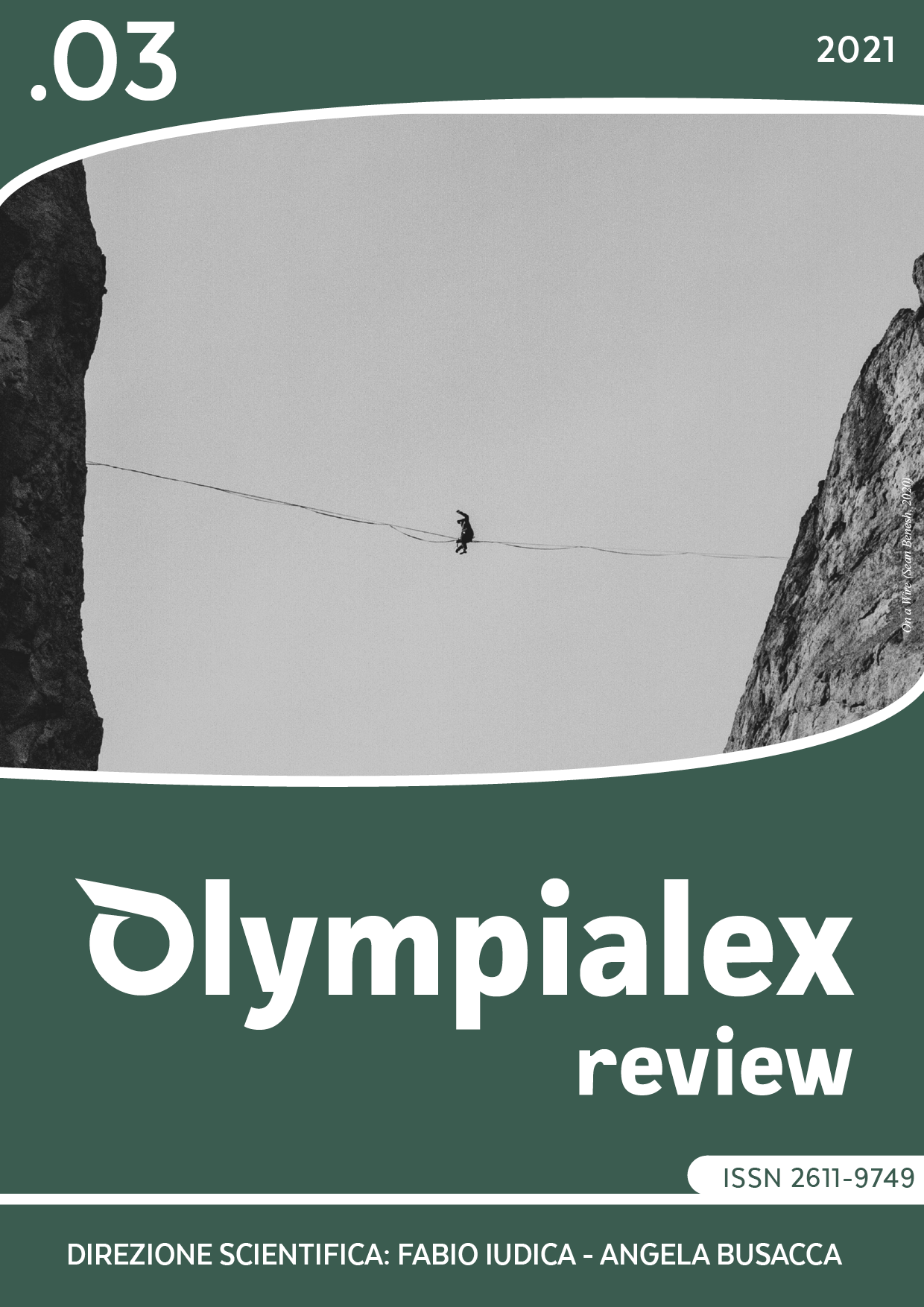
OLYMPIALEX REVIEW
N°03/2021
INDICE DEI CONTENUTI
PARTE I - STRUMENTIIL TITOLO SPORTIVO NELLA CRISI DELL’IMPRESA SPORTIVA (di Roberto Razzini)
SIDES AGREEMENTS NEL CALCIO PROFESSIONISTICO (di Alessandro Mazzucato)
PARTE II - FOCUS
LA “MARATONA” DELLA CITTADINANZA LE RAGIONI DELLO IUS SOLI E DELLO IUS CULTURAE (di Alessio Rauti)
BREVI NOTE IN TEMA DI ABUSI A SFONDO SESSUALE NEL MONDO SPORTIVO: VERSO UNA TUTELA (PIÙ EFFETTIVA) PER GLI ATLETI E LE ATLETE PIÙ GIOVANI? (di Angela Busacca)
SPORT EDUCATIVO E INTELLIGENZE MULTIPLE (di Rosa Sgambelluri)
LA RIFORMA DELLO SPORT COME “OCCASIONE” PER L’EMANCIPAZIONE DELLO SPORT FEMMINILE? RIFLESSIONI SU “SPERIAMO SIA UN PAREGGIO” DI FOLLI – GARATTI – PISANI (di Maria José Bravo Bosch)
PARTE III - TERZO TEMPO
CASO VERONA – ROMA: IL C.U. 83/A E IL BENE OGGETTO DI TUTELA (di Edoardo Damiani)
ABSTRACT E KEYWORDS
IL TITOLO SPORTIVO NELLA CRISI DELL’IMPRESA SPORTIVA (di Roberto Razzini)
Abstract:
L’articolo affronta il tema dell’azienda sportiva in crisi economica e della sorte del suo titolo sportivo, cercandone una definizione che, nel rispetto dell’autonomia degli ordinamenti, possa portare ad una “pacifica” convivenza degli interessi in gioco.
The article deals with the issue of sports clubs facing financial crisis and the possible solutions for the club’s sports license. The author seeks a solution which, despite the autonomy between the sports and the civil systems, may lead a “peaceful” coexistence of the interests in concern.
Keywords: sodalizio – crisi – asd – titolo – diritto – qualità
association – crisis – sports amateur club – sports title – right – quality
The article deals with the issue of sports clubs facing financial crisis and the possible solutions for the club’s sports license. The author seeks a solution which, despite the autonomy between the sports and the civil systems, may lead a “peaceful” coexistence of the interests in concern.
Keywords: sodalizio – crisi – asd – titolo – diritto – qualità
association – crisis – sports amateur club – sports title – right – quality
SIDES AGREEMENTS NEL CALCIO PROFESSIONISTICO (di Alessandro Mazzucato)
Abstract:
L’articolo analizza, partendo dalla descrizione del contratto di lavoro sportivo, alcune tipologie di accordi aggiuntivi che sono sempre più frequenti nel panorama calcistico italiano e internazionale quali la c.d. clausola rescissoria e le pattuizioni sullo sfruttamento del diritto di immagine del calciatore, per poi in ultima analisi porre l’attenzione sul modus operandi della S.S. Napoli Calcio.
The articles analyze, starting from a description of the employment’s contract under Italian laws discipline, some types of side agreement that are frequently found in the Italian and international football market such as the “buyout clause” and the agreements in use regarding the economic exploitation of a player’s image rights, concluding with a brief focus on the S.S. Napoli Calcio’s policy in that respect.
Keywords: clausola risolutiva – altre scritture – accordi collettivi – diritti di immagine
cláusula de rescisión – buy-out clause – collective agreements – image rights
The articles analyze, starting from a description of the employment’s contract under Italian laws discipline, some types of side agreement that are frequently found in the Italian and international football market such as the “buyout clause” and the agreements in use regarding the economic exploitation of a player’s image rights, concluding with a brief focus on the S.S. Napoli Calcio’s policy in that respect.
Keywords: clausola risolutiva – altre scritture – accordi collettivi – diritti di immagine
cláusula de rescisión – buy-out clause – collective agreements – image rights
LA “MARATONA” DELLA CITTADINANZA LE RAGIONI DELLO IUS SOLI E DELLO IUS CULTURAE (di Alessio Rauti)
Abstract:
Lo studio analizza i modelli ideali del concetto di cittadinanza e mette a fuoco, nel panorama comparato, i diversi criteri di ius soli e i temperamenti del criterio di ius sanguinis. Si sofferma inoltre sul rapporto fra una eventuale riforma della legge sulla cittadinanza e il c.d. ius soli sportivo.
The paper analyzes the ideal models of citizenship and it brings into focus, from a comparative perspective, the various ius soli criteria and the mitigation of the ius sanguinis criterion. Furthermore, it analyzes the relationship between a potential reform of the citizenship rules and the so-called sorting ius soli.
Keywords: cittadinanza – minori stranieri – sport – ius soli – ius culturae – ius sanguinis
citizenship – foreign minors – sport – ius soli – ius culturae – ius sanguinis
The paper analyzes the ideal models of citizenship and it brings into focus, from a comparative perspective, the various ius soli criteria and the mitigation of the ius sanguinis criterion. Furthermore, it analyzes the relationship between a potential reform of the citizenship rules and the so-called sorting ius soli.
Keywords: cittadinanza – minori stranieri – sport – ius soli – ius culturae – ius sanguinis
citizenship – foreign minors – sport – ius soli – ius culturae – ius sanguinis
BREVI NOTE IN TEMA DI ABUSI A SFONDO SESSUALE NEL MONDO SPORTIVO: VERSO UNA TUTELA (PIÙ EFFETTIVA) PER GLI ATLETI E LE ATLETE PIÙ GIOVANI? (di Angela Busacca)
Abstract:
Sull’onda del clamore mediatico suscitato da alcune vicende, prima fra tutte quella che ha interessato le ginnaste della squadra nazionale USA, si è squarciato il velo di silenzio che ha circondato per troppi anni il fenomeno degli abusi e delle molestie sessuali nello sport. Le circostanze nelle quali maturano le situazioni di abuso presentano caratteri del tutto peculiari, collegati alle caratteristiche stesse dei rapporti che si creano nell’ambiente sportivo: si tratta, nella maggior parte dei casi, di situazioni nelle quali un soggetto approfitta (e abusa) della propria posizione di supremazia per manipolare le vittime e ottenere i propri scopi. Raramente si assiste a fenomeni di coazione fisica, poiché spesso l’autore delle condotte (allenatore o dirigente o atleta con posizione di leader nella squadra) esercita una sorta di fascinazione perversa sulle vittime che presentano situazioni di fragilità e, in diversi casi, sono atleti ancora minorenni. La presenza di abusi sessuali nello sport rappresenta un problema purtroppo diffuso in tutto il mondo e che interessa molteplici attività sportive ma contro il quale solo negli ultimi anni le istituzioni sportive hanno assunto dei provvedimenti e delle linee di intervento severe. Prendendo come riferimento la situazione italiana, il presente saggio evidenzia come il sistema sportivo stia cercando di colmare la lacuna di tutela presente negli anni passati, attraverso un’opera più incisiva delle Corti di giustizia sportiva e una più matura consapevolezza della necessità di una normativa apposita per sanzionare gli abusi sessuali con la radiazione a vita. In conclusione, viene altresì proposto un confronto tra Italia e Spagna, che stanno entrambe vivendo una stagione di riforme del sistema sportivo, per evidenziare come anche il legislatore statale rilevi la necessità di apportare una tutela rafforzata alle atlete e agli atleti, particolarmente minori, vittime di violenza e molestie sessuali.
The veil of silence that has surrounded the phenomenon of abuse and sexual harassment in sport for too many years was torn apart in the wake of the media hype following some scandals, primarily the one regarding the gymnasts of the USA national team. The circumstances in which situations of abuse mature have quite peculiar characteristics, connected to the characteristics of the relationship between athletes and coaches and other subjects of sports organizations. In most cases, these are situations in which an individual takes advantage of (and abuses) a position of supremacy to manipulate the victims and achieve their purpose. We rarely see phenomena of physical compulsion, since often the perpetrator of the abuse (coach or manager or athlete with a position of leader in the team) exercises a sort of perverse fascination over often fragile victims and, in several cases, are underage athletes. The presence of sexual abuse in sport unfortunately represents a widespread global problem and affects many sporting activities against which only in recent years have the institutions of sport systems taken strict measures and introduced strategies of action. Taking the Italian situation as a reference, this essay highlights how the sports system is trying to fill the protection gap of the past years, through more incisive work of Sports Courts and more mature awareness of the need for specific legislation to sanction sexual abuse with lifetime suspension. In the final paragraph, a comparison is also proposed between Italy and Spain, both of which are experiencing a period of reforms in their sports systems, to underline how state legislature also highlights the need to provide enhanced protection to female athletes and underage athlete who are victims of sexual violence and harassment.
Keywords: ordinamento sportivo – abusi sessuali – allenatori – minori – giustizia sportiva
sport system – sexual harassment – coaches – underage athletes – sport system courts
The veil of silence that has surrounded the phenomenon of abuse and sexual harassment in sport for too many years was torn apart in the wake of the media hype following some scandals, primarily the one regarding the gymnasts of the USA national team. The circumstances in which situations of abuse mature have quite peculiar characteristics, connected to the characteristics of the relationship between athletes and coaches and other subjects of sports organizations. In most cases, these are situations in which an individual takes advantage of (and abuses) a position of supremacy to manipulate the victims and achieve their purpose. We rarely see phenomena of physical compulsion, since often the perpetrator of the abuse (coach or manager or athlete with a position of leader in the team) exercises a sort of perverse fascination over often fragile victims and, in several cases, are underage athletes. The presence of sexual abuse in sport unfortunately represents a widespread global problem and affects many sporting activities against which only in recent years have the institutions of sport systems taken strict measures and introduced strategies of action. Taking the Italian situation as a reference, this essay highlights how the sports system is trying to fill the protection gap of the past years, through more incisive work of Sports Courts and more mature awareness of the need for specific legislation to sanction sexual abuse with lifetime suspension. In the final paragraph, a comparison is also proposed between Italy and Spain, both of which are experiencing a period of reforms in their sports systems, to underline how state legislature also highlights the need to provide enhanced protection to female athletes and underage athlete who are victims of sexual violence and harassment.
Keywords: ordinamento sportivo – abusi sessuali – allenatori – minori – giustizia sportiva
sport system – sexual harassment – coaches – underage athletes – sport system courts
SPORT EDUCATIVO E INTELLIGENZE MULTIPLE (di Rosa Sgambelluri)
Abstract:
La dottrina pedagogica guarda allo sport come a un’attività dal forte potenziale educativo che permette di attuare un percorso di conoscenza delle diverse forme della propria personalità e di coniugare il rapporto tra “intenzione” e “azione”, nonché di concorrere al superamento di forme di insicurezza e disorientamento attraverso l’allenamento e il confronto in gara. Prendendo le mosse dal valore dello sport educativo, l’autrice ne evidenzia le caratteristiche, come strumento di conoscenza di sé e di comunicazione sociale, ed evidenzia altresì i rapporti con le diverse forme di intelligenza umana, sottolineando l’importanza dello sviluppo dell’intelligenza corporea per i bambini al fine di sviluppare le diverse e complementari forme di motricità che sono alla base delle attività sportive.
Educational science considers sport as a potentially highly educational activity that allows one to understand the multifaceted aspects of one’s own personality, successfully combining ‘intention’ and ‘action’, as well as contributing to overcoming forms of insecurity and disorientation through training and competing. Starting from valuing educational sport, the author highlights its characteristics as an instrument of learning social communication and one’s self. Furthermore, she points out the relation- ships with diverse forms of human intelligence, underlining the importance of the development of body intelligence for children with the aim of developing different, complementary forms of motion which are the basis of sports activities.
Keywords: sport “educativo” – promozione umana – sistema culturale - processo educativo – intelligenze umane – motricità
educative sport – human promotion – cultural system – educational process – human intelligence – motility
Educational science considers sport as a potentially highly educational activity that allows one to understand the multifaceted aspects of one’s own personality, successfully combining ‘intention’ and ‘action’, as well as contributing to overcoming forms of insecurity and disorientation through training and competing. Starting from valuing educational sport, the author highlights its characteristics as an instrument of learning social communication and one’s self. Furthermore, she points out the relation- ships with diverse forms of human intelligence, underlining the importance of the development of body intelligence for children with the aim of developing different, complementary forms of motion which are the basis of sports activities.
Keywords: sport “educativo” – promozione umana – sistema culturale - processo educativo – intelligenze umane – motricità
educative sport – human promotion – cultural system – educational process – human intelligence – motility
LA RIFORMA DELLO SPORT COME “OCCASIONE” PER L’EMANCIPAZIONE DELLO SPORT FEMMINILE? RIFLESSIONI SU “SPERIAMO SIA UN PAREGGIO” DI FOLLI – GARATTI – PISANI (di Maria José Bravo Bosch)
Abstract:
Lo sport femminile rappresenta, in Italia, un settore in continua evoluzione, sia con riferimento al numero di atleti sia all’interesse del pubblico di tifosi/spettatori: negli ultimi anni, infatti, non solo si sono moltiplicati i tesseramenti delle giovani atlete, ma altresì è aumentata la visibilità, sulla stampa specializzata e sui canali di comunicazione, delle manifestazioni (nazionali ed internazionali) più importanti e delle sportive più famose. A fronte di questa situazione, permangono tuttavia alcune discriminazioni in relazione al trattamento delle atlete come lavoratici, dal momento che la legge attualmente in vigore sul “professionismo sportivo” riguarda solo gli atleti uomini e relega le donne alla qualifica di “dilettanti”, senza accordare loro alcuna tutela dal punto di vista previdenziale. Un cambiamento sostanziale si è avuto, al momento solo sulla carta, con il d.lgs. n. 36/2021 che ha introdotto la figura del “lavoratore sportivo” senza distinzione di genere; tale Decreto, tuttavia non è ancora entrato in vigore e, anzi, sarà probabilmente oggetto di nuove modifiche. Queste evoluzioni dello sport femminile, tra criticità attuali e prospettive di riforma, sono al centro del libro di Maurizio Folli, Maria Luisa Garatti ed Elena Pisani intitolato “Speriamo sia un pareggio. Le donne, la riforma dello sport, la sfida del cambiamento”, che coniuga ricostruzione storica e approccio giuridico soffermandosi altresì su alcuni profili talvolta trascurati quali la formazione delle giovani atlete e lo sport femminile paralimpico. L’autrice presenta una panoramica dei punti di maggior interesse del libro proposto, prendendo spunto anche per una comparazione con la situazione spagnola, alla vigilia della riforma della “Ley Organica del Deporte”.
In Italy, Women’s sport is a constantly developing sector, both with reference to the number of athletes and to the interest of the fans. In recent years, indeed, not only has the membership of young competing female athletes increased, but also the visibility of the most important national and international events in female sports, in the specialized press and social media. Alongside this situation, however, much discrimination remains in relation to the situation of female athletes as workers, since the current law on “sports professionalism” only concerns male athletes and relegates women to the qualification of “amateurs”, without any legal guarantee regarding social security. A substantial change has occurred, at the moment only on paper, with legislative decree n. 36/2021 which introduced the new figure of “sports worker” without distinction of gender. This legislation, however, has not yet entered into force and will probably be subject to new amendments. The evolution of women’s sport, current criticalities and prospects for reform are all the main topics of the book by Maurizio Folli, Maria Luisa Garatti and Elena Pisani entitled “Speriamo sia un pareggio. Le donne, la riforma dello sport, la sfida del cambiamento”. It combines historical reconstruction and a legal approach, also focusing on some profiles that are often overlooked, such as the training of young athletes and Paralympic women’s sport. This review presents an overview of the points of greatest interest in the proposed book, also proposing a comparison with the Spanish situation, on the eve of the reform of the “Ley Organica del Deporte”.
Keywords: sport femminile – emancipazione – riforma – professionismo – sport paralimpico
female sport – emancipation – reform – professionalism – paralympic Sport
In Italy, Women’s sport is a constantly developing sector, both with reference to the number of athletes and to the interest of the fans. In recent years, indeed, not only has the membership of young competing female athletes increased, but also the visibility of the most important national and international events in female sports, in the specialized press and social media. Alongside this situation, however, much discrimination remains in relation to the situation of female athletes as workers, since the current law on “sports professionalism” only concerns male athletes and relegates women to the qualification of “amateurs”, without any legal guarantee regarding social security. A substantial change has occurred, at the moment only on paper, with legislative decree n. 36/2021 which introduced the new figure of “sports worker” without distinction of gender. This legislation, however, has not yet entered into force and will probably be subject to new amendments. The evolution of women’s sport, current criticalities and prospects for reform are all the main topics of the book by Maurizio Folli, Maria Luisa Garatti and Elena Pisani entitled “Speriamo sia un pareggio. Le donne, la riforma dello sport, la sfida del cambiamento”. It combines historical reconstruction and a legal approach, also focusing on some profiles that are often overlooked, such as the training of young athletes and Paralympic women’s sport. This review presents an overview of the points of greatest interest in the proposed book, also proposing a comparison with the Spanish situation, on the eve of the reform of the “Ley Organica del Deporte”.
Keywords: sport femminile – emancipazione – riforma – professionismo – sport paralimpico
female sport – emancipation – reform – professionalism – paralympic Sport
CASO VERONA – ROMA: IL C.U. 83/A E IL BENE OGGETTO DI TUTELA (di Edoardo Damiani)
Abstract:
L’articolo esamina le decisioni della Corte Sportiva d’Appello della FIGC del 10 novembre 2020 e quella del Collegio di Garanzia dello Sport del CONI del 13 maggio 2021 sulle impugnazioni, presentate dalla A.S. Roma, dirette ad ottenere l’annullamento della sconfitta a tavolino rimediata alla prima giornata di campionato della stagione sportiva 2020/2021. Premessi alcuni cenni sui fatti relativi alla vicenda, ci si sofferma sulle origini e sugli elementi rilevanti del Comunicato Ufficiale della FIGC n. 83/A del 2014, nonché sull’effettiva applicazione di tali previsioni da parte della giustizia sportiva, con particolare riferimento al bene giuridico oggetto di tutela.
The article analyses the decisions rendered by the Sports Court of Appeal of the Italian Football Associ- ation (FIGC) on 10 November 2020 and by the Sport Guarantee Board of the Italian Olympic Commit- tee (CONI) on 13 May 2020 in relation to A.S. Roma’s appeal against the first degree decision whereby the latter was sanctioned with a 3-0 defeat in the first championship day. After a brief introduction on the facts of the case, the article focuses on the rationale behind FIGC’s Official Notice No. 83/A of 2014 and the most relevant provisions thereof, as well as the actual application of the relevant byelaws by the sports justice bodies, particularly with respect to the legal asset protected thereunder.
Keywords: hellas verona f.c. – a.s. roma – partita – appello
hellas verona f.c. – a.s. roma – match – appeal
The article analyses the decisions rendered by the Sports Court of Appeal of the Italian Football Associ- ation (FIGC) on 10 November 2020 and by the Sport Guarantee Board of the Italian Olympic Commit- tee (CONI) on 13 May 2020 in relation to A.S. Roma’s appeal against the first degree decision whereby the latter was sanctioned with a 3-0 defeat in the first championship day. After a brief introduction on the facts of the case, the article focuses on the rationale behind FIGC’s Official Notice No. 83/A of 2014 and the most relevant provisions thereof, as well as the actual application of the relevant byelaws by the sports justice bodies, particularly with respect to the legal asset protected thereunder.
Keywords: hellas verona f.c. – a.s. roma – partita – appello
hellas verona f.c. – a.s. roma – match – appeal
SINGOLI ARTICOLI IN PDF
IL TITOLO SPORTIVO NELLA CRISI DELL’IMPRESA SPORTIVA (di Roberto Razzini)
SIDES AGREEMENTS NEL CALCIO PROFESSIONISTICO (di Alessandro Mazzucato)
LA “MARATONA” DELLA CITTADINANZA LE RAGIONI DELLO IUS SOLI E DELLO IUS CULTURAE (di Alessio Rauti)
BREVI NOTE IN TEMA DI ABUSI A SFONDO SESSUALE NEL MONDO SPORTIVO: VERSO UNA TUTELA (PIÙ EFFETTIVA) PER GLI ATLETI E LE ATLETE PIÙ GIOVANI? (di Angela Busacca)
SPORT EDUCATIVO E INTELLIGENZE MULTIPLE (di Rosa Sgambelluri)
LA RIFORMA DELLO SPORT COME “OCCASIONE” PER L’EMANCIPAZIONE DELLO SPORT FEMMINILE? RIFLESSIONI SU “SPERIAMO SIA UN PAREGGIO” DI FOLLI – GARATTI – PISANI (di Maria José Bravo Bosch)
CASO VERONA – ROMA: IL C.U. 83/A E IL BENE OGGETTO DI TUTELA (di Edoardo Damiani)





